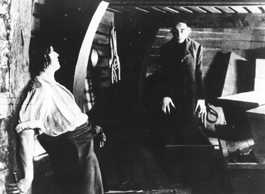home | metro santa cruz index | movies | current reviews | film review

The Rat boy cometh: Count Orlok closes in on a hapless victim in Murnau's 'Nosferatu,' playing Tuesday at the Del Mar.
'Nosferatu' On Halloween Eve
New Music Works score intensifies the vampire flick experience.
By Richard von Busack
In 1922, a doomed filmmaker created a vampire that still haunts the popular imagination. F.W. Murnau's Nosferatu was made under shadowy circumstances; so little is known that Phil Hardy's Encyclopedia of Horror Movies comments, "Orlok is allegedly played by Max Schreck." Murnau's tale is set in 1838, shot on the roads, woods and hills of a haunted Europe not yet overtaken by the internal combustion engine. Otherwise the story is familiar from Bram Stoker's novel. The Count needs more lively surroundings. He eats his way across the Mediterranean on a ship; he arrives to drink from the devoted wife of his realtor (Greta Schroeder, decked out in sausage curls). The final act takes place in the empty harbor city of Bremen, still medieval, not yet renovated by the RAF. The city is haunted by "Orlok" (the alias Dracula uses for legal purposes). In the most frightening moment, he rises out of his coffin without use of his hands or feet. At night, the count's speeded-up coach and horses scuttle through the woods like insects: it's a sight that's somehow on the other side of funny.
In the novel Dracula, the Count sounds most like Jack Palance, who played him on TV. The nose is high-bridged, with "peculiarly arched nostrils" but also with other jarring features Palance didn't possess: a bulbous forehead, hairy, curling eyebrows, furry palms, a thick mustache curling over peculiar sharp teeth protruding over very red lips: "abstractly vaginal," to steal a phrase from artist Miranda July—though abstractly vagina dentata is more like it.
Schreck is nothing like that pale hairy count, neither a dapper, oily Magyar like Bela Lugosi nor coldly furious like Christopher Lee. The Nosferatu has a rodent's chisel teeth, a hanging sailor's pea coat, some wild hair around his ears; he's a vulture/spider on two legs, a new breed of parasite, homo rattus.
On Halloween Eve, Phil Collins and six members of the New Music Works reprise their 2003 soundtrack to the silent film starring this character. Nosferatu was made under illegal circumstances and pulled by the rightful owner of Dracula, Bram Stoker's widow, which complicated Collins' task 80 years later. In 2003 Collins discussed the matter with Metro Santa Cruz's Steve Palopoli and explained that there were so many different versions of the film that nothing seemed quite authoritative. "It's gotten very frustrating," Collins said. "I worked last summer with a VHS from the library that was 61 minutes. Then I got introduced to another version that was 84 minutes. And then one that the Silent Orchestra is pushing very hard that is 81 minutes."
In reprising this score, Collins and his orchestra join the multitudes who have brought music to Nosferatu: they include Hammer Films scorer James Bernard and San Francisco's Club Foot Orchestra. Perhaps no other silent film has attracted so many musicians, all intrigued by the film's subtitle, "A Symphony of Terrors."
It's not especially gory. A "blurry Gothic romance," Carlos Clarens calls Nosferatu in An Illustrated History of Horror Film. But the lack of blood in the film is made up for by the other feature of the evening: a parked Red Cross bloodmobile taking donations out front. Certainly, this Nosferatu is better if seen slightly light-headed from blood loss.
![]() The silent film NOSFERATU is set to an original score written by Phil Collins and performed by New Music Works on Tuesday, Oct. 30 at 7pm at the Del Mar Theatre, 1124 Pacific Ave., Santa Cruz. Tickets are $18 general/$16 seniors and students, with a $2 discount for giving blood. For information see www.santacruzfilmfestival.com.
The silent film NOSFERATU is set to an original score written by Phil Collins and performed by New Music Works on Tuesday, Oct. 30 at 7pm at the Del Mar Theatre, 1124 Pacific Ave., Santa Cruz. Tickets are $18 general/$16 seniors and students, with a $2 discount for giving blood. For information see www.santacruzfilmfestival.com.
Send a letter to the editor about this story.
|
|
|
|
|
|